2025 Author: Erin Ralphs | [email protected]. Last modified: 2025-06-01 05:35:55
In the USSR, close attention was paid to tractor construction. Agriculture needed speedy mechanization, and there were no own factories in the country. Realizing the need to increase labor productivity in the countryside, V. I. Lenin in 1920 signed the corresponding decree "On a single tractor farm." Already in 1922, small-scale production of domestic models "Kolomenets" and "Zaporozhets" began. The first tractors of the USSR were technically imperfect and low-powered, but after two five-year plans, a breakthrough came in the construction of specialized enterprises.
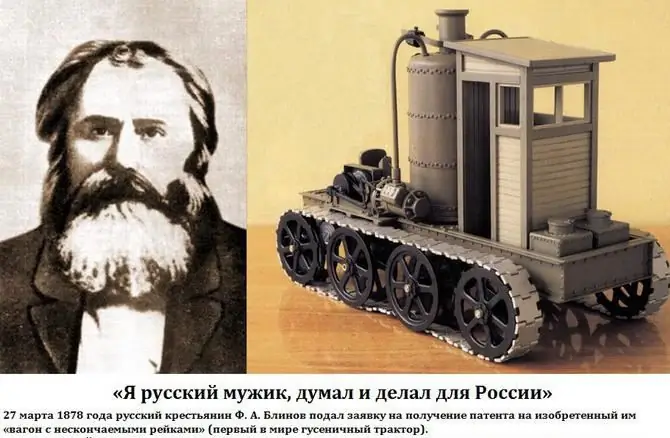
"Russian" firstborn
Russia has always been famous for its inventors, but not all ideas have been put into practice. Back in the 18th century, the agronomist I. M. Komov raised the topic of the mechanization of agriculture. In the middle of the 19th century, V. P. Guryev, and then D. A. Zagryazhsky, developed steam tractors for plowing. In 1888, F. A. Blinov made and tested the first steam tractor oncaterpillar track. However, the device turned out to be unnecessarily bulky. However, 1896 is officially considered the year of birth of the Russian tractor industry, when the world's first caterpillar steam tractor was publicly demonstrated at the Nizhny Novgorod Fair.
On the threshold of the 20th century, designer Ya. It was more suitable than any other for use in wheeled tracked vehicles. In 1911, he also assembled the first domestic tractor with an 18-kilowatt internal combustion engine, which received the patriotic name "Russian". After modernization, a more powerful engine appeared on it - by 33 kW. Their small-scale production was established at the Balakovo plant - about a hundred units were produced before 1914.
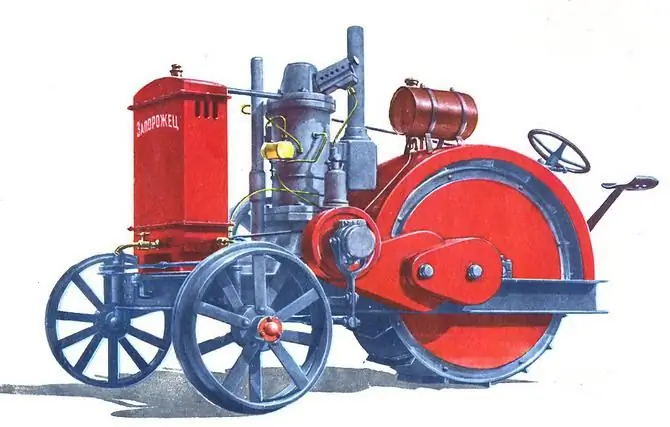
In addition to Balakovo, piece tractors were produced in Bryansk, Kolomna, Rostov, Kharkov, Barvenkovo, Kichkas and a number of other settlements. But the total production of all tractors at domestic enterprises was so small that it had practically no effect on the situation in agriculture. In 1913, the total number of this equipment is estimated at 165 copies. On the other hand, foreign agricultural equipment was actively purchased: by 1917, 1,500 tractors were imported into the Russian Empire.
History of tractors in the USSR
At the initiative of Lenin, special attention was paid to the development and production of mechanized agricultural machinery. The principle of a single tractor economy assumed not only the production of ironhorses, as tractors were called, but also a set of measures to organize a research and testing base, organize the supply of spare parts and repairs, open courses for craftsmen, instructors and tractor drivers.
The first tractor in the USSR was produced by the Kolomna Plant in 1922. The founder of the national school of tractor building, E. D. Lvov, became the project manager. The wheeled vehicle was called "Kolomenets-1" and symbolized the beginning of a new era in the countryside. Lenin, despite a serious illness, personally congratulated the designers on their success.
In the same year, the Krasny Progress enterprise produced the Zaporozhets tractor in Kichkass. The model was not perfect. Only one rear wheel was driving. A low-power two-stroke motor of 8.8 kW accelerated the “iron horse” to 3.4 km / h. There was only one gear, forward. Power on the hook - 4, 4 kW. But even this vehicle greatly facilitated the work of the villagers.
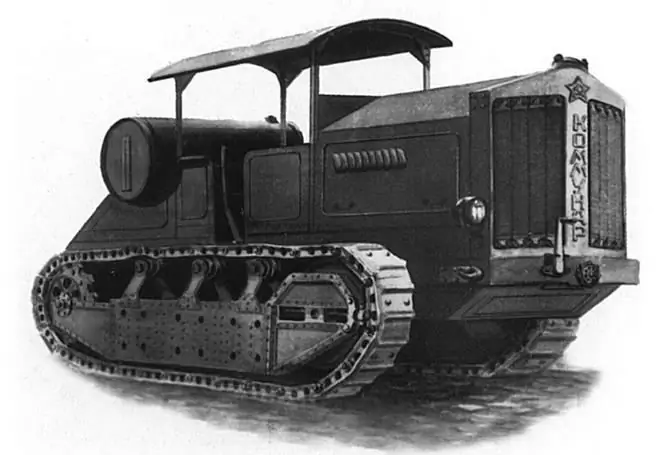
The legendary inventor Mamin did not sit idle. He improved his pre-revolutionary design. In 1924, the tractors of the USSR were replenished with models of the Karlik family:
- Three-wheeled "Karlik-1" with one gear and a speed of 3-4 km/h.
- Four-wheel "Dwarf-2" with reverse.
Learning from foreign experience
While the USSR tractors were "building up their muscles", and Soviet designers were mastering a new direction for themselves, the government decided to start producing foreign equipment under license. In 1923, the tracked Kommunar was put into production at the Kharkov plant, which washeir to the German model "Ganomag Z-50". They were mainly used in the army for transporting artillery pieces until 1945 (and later).
In 1924, the Leningrad plant "Krasny Putilovets" (future Kirovsky) mastered the production of a cheap and structurally simple "American" of the Fordson company. The old USSR tractors of this brand have proven themselves quite well. They were head and shoulders above both Zaporozhets and Kolomenets. Carburetor kerosene engine (14.7 kW) developed a speed of up to 10.8 km / h, power on the hook - 6.6 kW. Gearbox - three-speed. The model was produced until 1932. In fact, this was the first large-scale production of this technique.
Construction of tractor factories
It has become obvious that in order to provide collective farms with productive tractors, it is necessary to build specialized plants that combine science, design bureaus and production facilities. The initiator of the project was F. E. Dzerzhinsky. According to the concept, it was planned to equip new enterprises with modern equipment and mass-produce cheap and reliable models on wheeled and caterpillar traction.
The first large-scale production of tractors in the USSR was established in Stalingrad. Subsequently, the capacities of the Kharkov and Leningrad plants were significantly expanded. Large enterprises appeared in Chelyabinsk, Minsk, Barnaul and other cities of the USSR.
Stalingrad Tractor Plant
Stalingrad became the city where the first large tractor plant was built from scratch. Thanks tostrategic position (at the intersection of supplies of Baku oil, Ural metal and Donbass coal) and the presence of an army of skilled labor, he won the competition from Kharkov, Rostov, Zaporozhye, Voronezh, Taganrog. In 1925, a resolution was adopted on the construction of a modern enterprise, and in 1930 the legendary wheeled tractors of the USSR of the STZ-1 brand left the assembly line. In the future, a wide range of wheeled and tracked models was produced here.
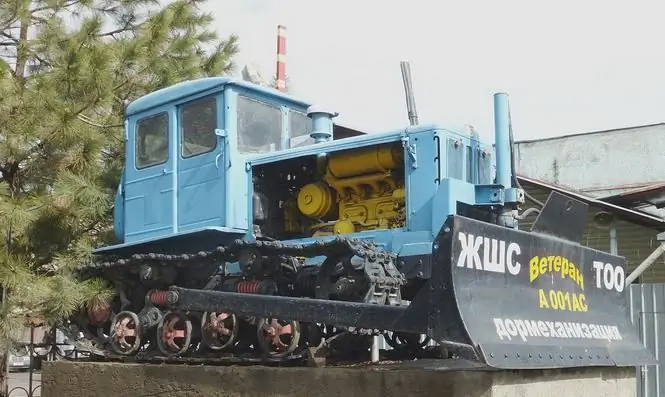
The Soviet period includes:
- STZ-1 (wheeled, 1930).
- SKhTZ 15/30 (wheeled, 1930).
- STZ-3 (caterpillar, 1937).
- SKHTZ-NATI (caterpillar, 1937).
- DT-54 (caterpillar, 1949).
- DT-75 (caterpillar, 1963).
- DT-175 (caterpillar, 1986).
In 2005, the Volgograd Tractor Plant (former STZ) was declared bankrupt. VgTZ became its successor.
DT-54
Crawler tractors of the USSR in the middle of the 20th century became widespread, they surpassed wheeled ones in the number of models. An excellent example of general-purpose agricultural machinery is the DT-54 tractor, produced in 1949-1979. It was produced at the Stalingrad, Kharkov and Altai plants with a total of 957,900 units. He "starred" in many films ("Ivan Brovkin in the virgin lands", "It was in Penkovo", "Kalina Krasnaya" and others), installed as a monument in dozens of settlements.
D-54 brand engine, in-line, four-cylinder, four-stroke, liquid-cooled, on a frameinstalled hard. The number of revolutions (power) of the motor is 1300 rpm (54 hp). A five-speed three-way gearbox with the main clutch is connected by a cardan drive. Working speed: 3.59-7.9 km/h, pulling force: 1000-2850kg.
Kharkov Tractor Plant
Construction of KhTZ im. Sergo Ordzhonikidze began in 1930, 15 kilometers east of Kharkov. In total, the construction of the giant took 15 months. The first tractor left the conveyor on October 1, 1931 - it was a borrowed model of the Stalingrad plant SHTZ 15/30. But the main task was to create a domestic tractor of the Caterpillar type with a capacity of 50 horsepower. Here, the team of designer P. I. Andrusenko developed a promising diesel unit that could be installed on all caterpillar tractors of the USSR. In 1937, the plant launched a modernized tracked model based on SKhTZ-NATI into a series. The main innovation was a more economical and at the same time more efficient diesel engine.
With the beginning of the war, the enterprise was evacuated to Barnaul, where the Altai Tractor Plant was created on its basis. After the liberation of Kharkov in 1944, production was resumed at the same site - the legendary USSR tractors of the SHTZ-NATI model again went into series. The main models of HZT of the Soviet period:
- SKhTZ 15/30 (wheeled, 1930).
- SHZT-NATI ITA (caterpillar, 1937).
- KhTZ-7 (wheeled, 1949).
- KhTZ-DT-54 (caterpillar, 1949).
- DT-14 (caterpillar, 1955).
- T-75 (caterpillar, 1960).
- T-74 (caterpillar, 1962).
- T-125 (caterpillar, 1962).
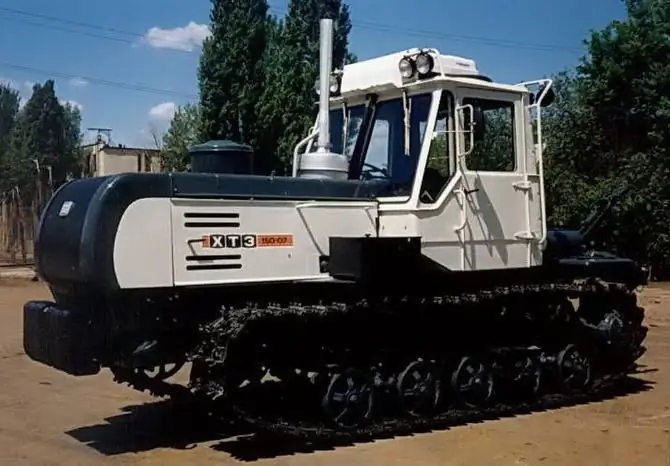
In the 1970s, a radical reconstruction was carried out at KhTZ, but production did not stop. Emphasis was placed on the production of "three-ton" T-150K (wheeled) and T-150 (tracked). The energy-saturated T-150K on tests in the USA (1979) showed the best performance among world analogues, proving that the tractors of the USSR times were not inferior to foreign ones. In the late 80s, the KhTZ-180 and KhTZ-200 models were developed: they are 20% more economical than the 150th series and 50% more productive.
T-150
Tractors of the USSR were famous for their reliability. So the universal high-speed tractor T-150 (T-150K) has earned a good reputation. It has a wide range of applications: transport, road construction, and agriculture. It is still used to transport goods on difficult terrain, in field work (plowing, peeling, cultivation, etc.), in earthworks. Able to transport trailers with a carrying capacity of 10-20 tons. For the T-150 (K), a turbocharged 6-cylinder liquid-cooled V-configuration diesel engine was specially developed.
Specifications T-150K:
- Width/length/height, m. - 2, 4/5, 6/3, 2.
- Track gauge, m. - 1, 7/1, 8.
- Weight, t. - 7, 5/8, 1.
- Power, hp - 150.
- Maximum speed, km/h - 31.
Minsk Tractor Plant
MTZ was founded on May 29, 1946 and is considered, perhaps, the most successful enterprise at the moment, which has retainedpower since the Soviet Union. At the end of 2013, over 21,000 people worked here. The plant holds 8-10% of the world tractor market and is strategic for Belarus. Produces a wide range of vehicles under the brand name "Belarus". By the time the Soviet Union collapsed, almost 3 million pieces of equipment had been produced.
- KD-35 (caterpillar, 1950).
- KT-12 (tracked, 1951).
- MTZ-1, MTZ-2 (wheeled, 1954).
- TDT-40 (caterpillar, 1956).
- MTZ-5 (wheeled, 1956).
- MTZ-7 (wheeled, 1957).
In 1960, a large-scale reconstruction of the Minsk plant began. In parallel with the installation of new equipment, the designers worked on the introduction of promising models of tractors: the MTZ-50 and the more powerful MTZ-52 with all-wheel drive. They went into the series, respectively, in 1961 and 1964. Since 1967, the tracked modification of the T-54V has been produced in various versions. If we talk about the unusual tractors of the USSR, then these can be considered modifications of the cotton-growing MTZ-50X with twin front wheels and increased ground clearance, which have been produced since 1969, as well as the steep MTZ-82K.
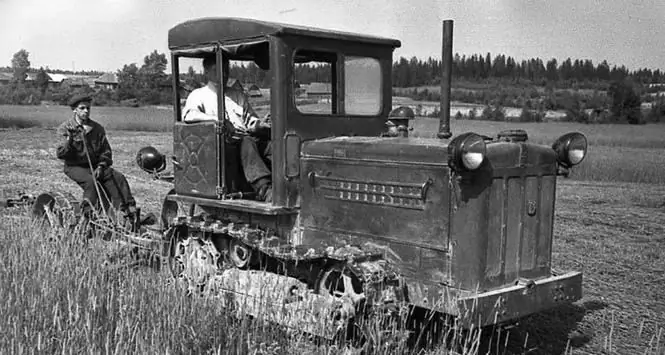
The next step was the MTZ-80 line (since 1974) - the most massive in the world, and special modifications MTZ-82R, MTZ-82N. Since the mid-80s, MTZ has mastered the technique of over a hundred horsepower: MTZ-102 (100 hp), MTZ-142 (150 hp), and low-power mini-tractors: 5, 6, 8, 12, 22 l. s.
KD-35
Crawler row-crop tractor is compact in size, easy to operate and repair. It was widely used in agriculture of the USSR and in the countries of the Warsaw Pact. Purpose - work with a plow and other attachments. Since 1950, a modification of the KDP-35 was produced, which was distinguished by a smaller width of tracks, a wider track and increased ground clearance.
A fairly powerful D-35 engine, respectively, gave out 37 hp. with., the gearbox had 5 steps (one back, five forward). The engine was economical: the average consumption of diesel fuel per 1 ha was 13 liters. A tank of fuel was enough for 10 hours of work - this was enough to plow 6 hectares of land. Since 1959, the model was equipped with a modernized D-40 power unit (45 hp) and an increased speed (1600 rpm). The reliability of the undercarriage has also been improved.
Chelyabinsk Tractor Plant before the war
Telling about the tractor of the USSR, it is impossible to get around the history of the Chelyabinsk plant, which made a significant contribution to the production of peaceful equipment, and during the Second World War it became a forge of tanks and self-propelled guns. The famous ChTZ was built in an open field away from highways with the help of picks, crowbars and shovels. The decision to build was made in May 1929 at the 14th Congress of Soviets of the USSR. In June 1929, Leningradsky GIPROMEZ began work on the design of the plant. ChTZ was designed taking into account the experience of American auto and tractor enterprises, mainly Caterpillar.
From February to November 1930, a pilot plant was built and put into operation. This happened on November 7, 1930. The founding date of ChTZ is considered to be August 10, 1930, when the first foundations were laid.foundry shop. On June 1, 1933, the first caterpillar tractor of Chelyabinsk workers, the Stalinets-60, left for the readiness line. In 1936, more than 61,000 tractors were produced. Now it is a retro-tractor of the USSR, and in the 30s, the S-60 model was almost twice as superior in performance as its counterparts from the Stalingrad and Kharkov plants.
In 1937, having simultaneously mastered the production of S-60 diesel engines, the plant switched to the production of more economical S-65 tractors. A year later, this tractor was awarded the highest Grand Prix award at an exhibition in Paris, and was also used to film the cult Soviet film Tractor Drivers. In 1940, the Chelyabinsk Tractor Plant was ordered to switch to the production of military products - tanks, self-propelled units, engines, spare parts.
Post-war history
Despite the difficulties of wartime, tractor builders did not forget about their favorite work. The thought arose: why not use the experience of the Americans? After all, in the United States during the war, the production of tractors did not stop. The analysis showed that the best of the models of American tractors is the D-7. Documentation and design began in 1944.
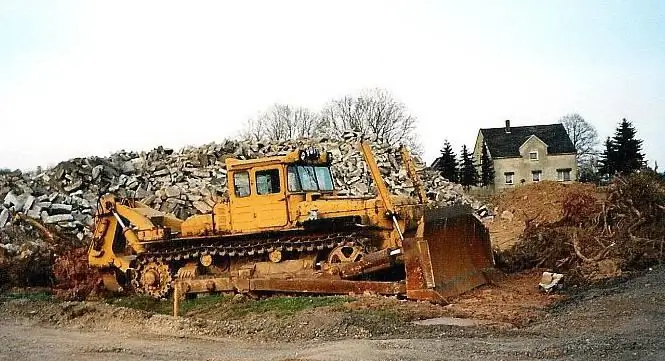
After 2 years, simultaneously with the reconstruction of the plant, on January 5, 1946, the first S-80 tractor was produced. By 1948, the restructuring of the enterprise was completed, 20-25 units of tracked vehicles were produced per day. In 1955, the design bureaus began work on the creation of a new, more powerful S-100 tractor and continued work to increase the durability of the S-80 tractor.
Models:
- S-60 (caterpillar, 1933).
- S-65 (caterpillar, 1937).
- S-80 (caterpillar, 1946).
- S-100 (caterpillar, 1956).
- DET-250 (caterpillar, 1957).
- T-100M (tracked, 1963).
- T-130 (caterpillar, 1969).
- T-800 (caterpillar, 1983).
- T-170 (caterpillar, 1988).
- DET-250M2 (caterpillar, 1989);.
- T-10 (caterpillar, 1990).
DET-250
In the late 50s, the task was set: to design and manufacture for testing prototypes of a tractor with a capacity of 250 horsepower. From the very first steps, the authors of the new model abandoned the traditional and well-known paths. For the first time in the practice of Soviet tractor construction, they created a hermetic and comfortable cab with air conditioning. The driver could drive a heavy car with one hand. The result was an excellent tractor DET-250. The Committee of the VDNKh Council of the USSR awarded the plant for this model with a Gold Medal and a Diploma of the 1st degree.
Other manufacturers
Of course, not all tractor factories are represented in the list. Tractors of the USSR and Russia were also produced and are being produced at the Altai (Barnaul), Kirov (Petersburg), Onega (Petrozavodsk), Uzbek (Tashkent) TZ, in Bryansk, Vladimir, Kolomna, Lipetsk, Moscow, Cheboksary, Dnepropetrovsk (Ukraine), Tokmak (Ukraine), Pavlodar (Kazakhstan) and other cities.
Recommended:
KAMAZ 5410 - the first of the truck tractors
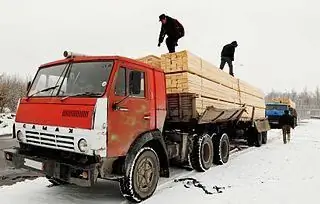
KAMAZ 5410 is a legendary truck. By the way, did you know that it was originally called… ZIL-170? These and other interesting facts are given in this article
Crawler mini tractor: brief description and recommendations
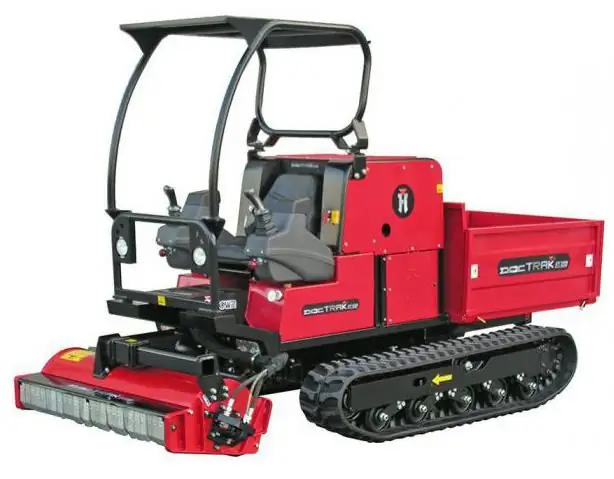
Modern caterpillar minitractor is a unique, multifunctional machine capable of solving many tasks. We will talk about it in the article
What is the immobilizer crawler for?

Under the expression "immobilizer bypass" means a number of technologies, the use of which allows you to start the car using the key. All of these technologies are combined under one word "bypass"
Crawler all-terrain vehicle "Beaver"
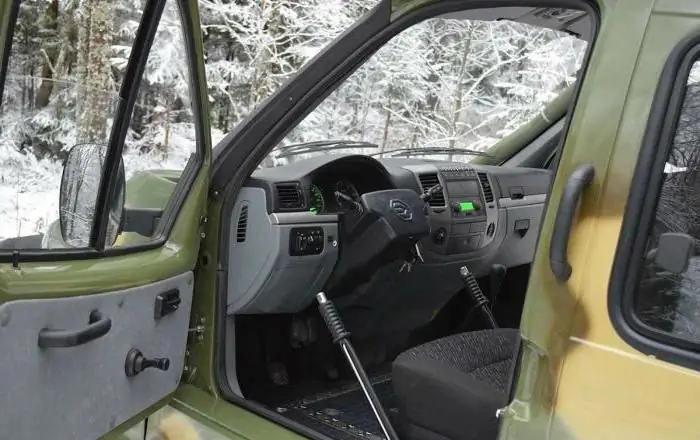
In our country there will always be a place that is colloquially called off-road, that is, impassable areas, etc. Despite the difficult accessibility of places, there are always tasks that must be performed there (be it hunting, fishing , exploration, search and rescue operations). What to do if it is necessary to move not only people, but also to deliver cargo across such terrain? Of course, you should use specialized equipment - caterpillar snow and swamp vehicles
Crawler all-terrain vehicle "Chetra" TM-140: description, specifications and reviews
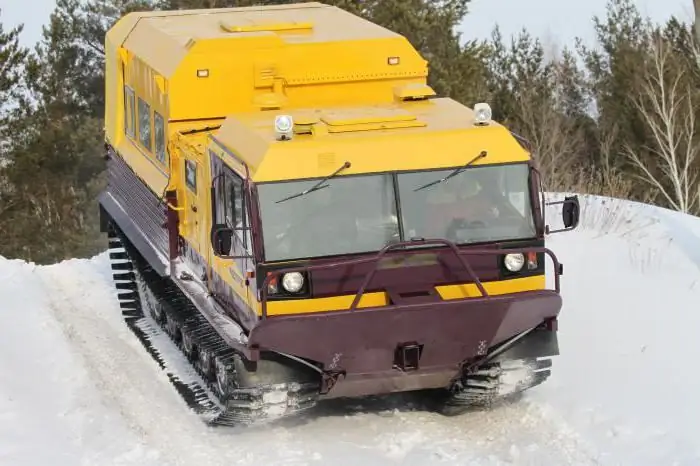
The scientific and technical potential of one of the leading manufacturers of armored vehicles, the Kurgan Machine-Building Plant, is embodied in the unique Chetra TM-140 floating tracked all-terrain vehicle. and geological exploration

